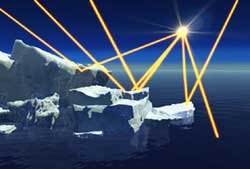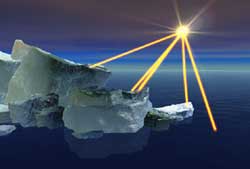- NASA Home
- | Centers
- | Goddard Home
- | News
- | Top Story
- | 2005
Feature
Black and White: Soot on Ice
03.23.05
Images above: This is a conceptual animation showing how polar ice reflects light from the sun. As this ice begins to melt, less sunlight gets reflected into space. It is instead absorbed into the oceans and land, raising the overall temperature, and fueling further melting. Darker, soot-covered ice reflects less light as well, part of the warming effect (no audio). Click on either image to view animation. Credit: NASA
NASA has been exploring how black carbon or soot affects the Earth's climate, by using satellite data and computer models that recreate the climate. New findings show that soot may be contributing to changes happening at the North Pole, such as increasing melting of sea ice and snow and warming atmospheric temperatures.
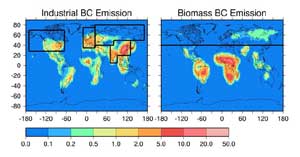 Image to right: Black Carbon Emissions: Industrial and biomass black carbon emissions with boxed areas showing regions assumed in the model experiments. Click on image to enlarge. Credit: NASA/GISS
Image to right: Black Carbon Emissions: Industrial and biomass black carbon emissions with boxed areas showing regions assumed in the model experiments. Click on image to enlarge. Credit: NASA/GISSDorothy Koch of Columbia University, N.Y. and NASA's Goddard Institute for Space Studies (GISS), New York, and James Hansen of NASA GISS are co-authors of the study that appeared in a recent issue of the Journal of Geophysical Research.
"This research offers additional evidence that black carbon may have a significant warming impact on the Arctic," Koch said. Warmer temperatures in the Arctic mean melting ice and snow, among other things. These temperature and ice changes also wind up affecting climate patterns around the world.
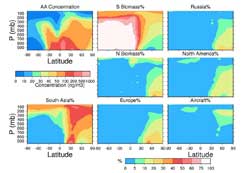 Image to left: Regional Concentrations of Black Carbon: (top left) Annual zonal mean black carbon concentration and percent contributions from regional experiments. Click on image to enlarge. Credit: NASA/GISS
Image to left: Regional Concentrations of Black Carbon: (top left) Annual zonal mean black carbon concentration and percent contributions from regional experiments. Click on image to enlarge. Credit: NASA/GISSThe Arctic is especially vulnerable to pollution. In recent years the Arctic has significantly warmed, and sea-ice cover and glaciers have diminished. Likely causes for these trends include changing weather patterns and the effects of pollution. Airborne soot also warms the air and affects weather patterns and clouds.
Black carbon has already been implicated as playing a role in melting ice and snow. Basically, when soot falls on ice, it darkens the surface and accelerates melting by absorbing more sunlight than ice would, just as wearing a black shirt in the summertime makes you feel hotter than if you wore a lighter color. Dark colors absorb heat and light, and lighter colors reflect it keeping surfaces cooler.
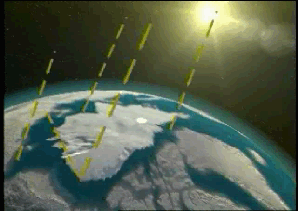 Image to right: Global Reflections: This is a conceptual animation showing how melting ice on land and at sea, can affect the surrounding ocean water, changing both the chemistry and relative sea level. Click on image to view animation (no audio). Credit: NASA
Image to right: Global Reflections: This is a conceptual animation showing how melting ice on land and at sea, can affect the surrounding ocean water, changing both the chemistry and relative sea level. Click on image to view animation (no audio). Credit: NASAKoch and Hansen used a NASA computer model and information gathered by many NASA satellites to get their finding.
The research found that in the atmosphere over the Arctic, about one-third of the soot comes from South Asia, one-third from burning biomass or vegetation around the world, and the remainder from Russia, Europe and North America.
South Asia is estimated to have the largest industrial soot emissions in the world, and the meteorology in that region readily sweeps pollution into the upper atmosphere where it is easily transported to the North Pole. Meanwhile, the pollution from Europe and Russia travels closer to the surface.
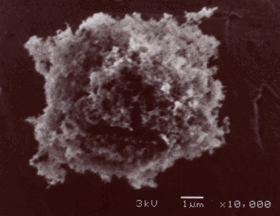 Image to left: Soot Particle Under a Microscope - Credit: D.M. Smith, University of Denver
Image to left: Soot Particle Under a Microscope - Credit: D.M. Smith, University of DenverDuring the early 1980s the main sources of Arctic pollution are believed to have been from Russia and Europe. Both of those areas have decreased their tiny particles of pollution in the last 20 years, but the pollution from South Asia has increased. Koch and Hansen suggest that Southern Asia also makes the greatest contribution to soot deposited on Greenland.
By exploring processes in the Earth’s atmosphere, NASA scientists are seeking answers to how pollutants like soot are changing the climate of the world around us.
Goddard Space Flight Center
